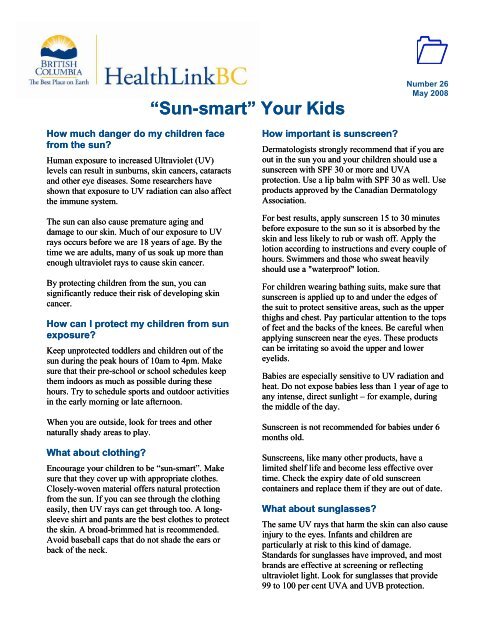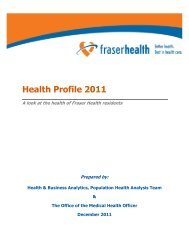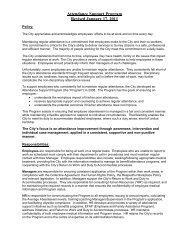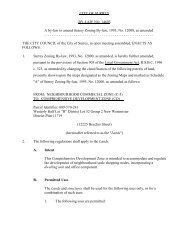"Sun-smart" Your Kids - HealthLink BC File #26 - Printer-friendly ...
"Sun-smart" Your Kids - HealthLink BC File #26 - Printer-friendly ...
"Sun-smart" Your Kids - HealthLink BC File #26 - Printer-friendly ...
You also want an ePaper? Increase the reach of your titles
YUMPU automatically turns print PDFs into web optimized ePapers that Google loves.
“<strong>Sun</strong>-smart” <strong>Your</strong> <strong>Kids</strong><br />
Number 26<br />
May 2008<br />
How much danger do my children face<br />
from the sun?<br />
Human exposure to increased Ultraviolet (UV)<br />
levels can result in sunburns, skin cancers, cataracts<br />
and other eye diseases. Some researchers have<br />
shown that exposure to UV radiation can also affect<br />
the immune system.<br />
The sun can also cause premature aging and<br />
damage to our skin. Much of our exposure to UV<br />
rays occurs before we are 18 years of age. By the<br />
time we are adults, many of us soak up more than<br />
enough ultraviolet rays to cause skin cancer.<br />
By protecting children from the sun, you can<br />
significantly reduce their risk of developing skin<br />
cancer.<br />
How can I protect my children from sun<br />
exposure?<br />
Keep unprotected toddlers and children out of the<br />
sun during the peak hours of 10am to 4pm. Make<br />
sure that their pre-school or school schedules keep<br />
them indoors as much as possible during these<br />
hours. Try to schedule sports and outdoor activities<br />
in the early morning or late afternoon.<br />
When you are outside, look for trees and other<br />
naturally shady areas to play.<br />
What about clothing?<br />
Encourage your children to be “sun-smart”. Make<br />
sure that they cover up with appropriate clothes.<br />
Closely-woven material offers natural protection<br />
from the sun. If you can see through the clothing<br />
easily, then UV rays can get through too. A longsleeve<br />
shirt and pants are the best clothes to protect<br />
the skin. A broad-brimmed hat is recommended.<br />
Avoid baseball caps that do not shade the ears or<br />
back of the neck.<br />
How important is sunscreen?<br />
Dermatologists strongly recommend that if you are<br />
out in the sun you and your children should use a<br />
sunscreen with SPF 30 or more and UVA<br />
protection. Use a lip balm with SPF 30 as well. Use<br />
products approved by the Canadian Dermatology<br />
Association.<br />
For best results, apply sunscreen 15 to 30 minutes<br />
before exposure to the sun so it is absorbed by the<br />
skin and less likely to rub or wash off. Apply the<br />
lotion according to instructions and every couple of<br />
hours. Swimmers and those who sweat heavily<br />
should use a "waterproof" lotion.<br />
For children wearing bathing suits, make sure that<br />
sunscreen is applied up to and under the edges of<br />
the suit to protect sensitive areas, such as the upper<br />
thighs and chest. Pay particular attention to the tops<br />
of feet and the backs of the knees. Be careful when<br />
applying sunscreen near the eyes. These products<br />
can be irritating so avoid the upper and lower<br />
eyelids.<br />
Babies are especially sensitive to UV radiation and<br />
heat. Do not expose babies less than 1 year of age to<br />
any intense, direct sunlight – for example, during<br />
the middle of the day.<br />
<strong>Sun</strong>screen is not recommended for babies under 6<br />
months old.<br />
<strong>Sun</strong>screens, like many other products, have a<br />
limited shelf life and become less effective over<br />
time. Check the expiry date of old sunscreen<br />
containers and replace them if they are out of date.<br />
What about sunglasses?<br />
The same UV rays that harm the skin can also cause<br />
injury to the eyes. Infants and children are<br />
particularly at risk to this kind of damage.<br />
Standards for sunglasses have improved, and most<br />
brands are effective at screening or reflecting<br />
ultraviolet light. Look for sunglasses that provide<br />
99 to 100 per cent UVA and UVB protection.
When buying sunglasses, see how well they cover<br />
the eyes. Large lenses, glasses that fit snugly, and a<br />
wraparound design all help protect against<br />
damaging UV rays. Have your clear plastic or glass<br />
corrective lenses checked for UV protection.<br />
Other Dangers<br />
Be extra careful with children who are fair-skinned<br />
or who have blond or red hair. They are more likely<br />
to burn easily and most at risk of developing skin<br />
cancer later in life.<br />
Most of the sun's damaging UV rays can penetrate<br />
light cloud cover and haze, so remember to protect<br />
your child even if it is cloudy or does not feel hot.<br />
Rays from the sun reflect off many of the surfaces<br />
around us. Up to 80 per cent of the sun's UV<br />
radiation can be reflected off snow. Concrete, sand<br />
and water reflect less than 20 per cent. Children<br />
always need to be “sun-smart” whether they are<br />
skiing, swimming, playing or walking outdoors.<br />
For more information, see <strong>HealthLink</strong> <strong>BC</strong> <strong>File</strong> 35<br />
Heat-related Illness.<br />
Tips to Increase <strong>Sun</strong> Safety<br />
Protect skin from the sun everyday from late<br />
spring through to early fall.<br />
Protect your skin from 10am until 4pm.<br />
Do not expose babies less than 1 year of age to<br />
any intense, direct sunlight which is usually<br />
from 10am to 4pm.<br />
Wear long-sleeved shirts, pants, a hat and<br />
sunglasses.<br />
If you have to go out in the sun without<br />
protective clothing, use sunscreen. Do not<br />
forget to apply it to ears, nose, and neck.<br />
Keep in mind that sunscreen is intended to<br />
enhance protection during periods of sun<br />
exposure – not to increase time of sun exposure.<br />
A tan does not provide enough protection<br />
against the sun’s rays. Actually, having a tan<br />
means that your skin has been damaged already<br />
by UV radiation.<br />
Help teach children to be “sun-smart” and to<br />
protect themselves against a lifetime of<br />
exposure to the sun.<br />
Indoor tanning or using sun lamps will damage<br />
your skin the same way that UV from the sun<br />
does.<br />
For more <strong>HealthLink</strong> <strong>BC</strong> <strong>File</strong> topics, visit<br />
www.<strong>HealthLink</strong><strong>BC</strong>.ca/healthfiles/index.stm<br />
or your local public health unit.<br />
Click on www.<strong>HealthLink</strong><strong>BC</strong>.ca or call 8-1-1<br />
for non-emergency health information<br />
and services in B.C.<br />
For deaf and hearing-impaired assistance,<br />
call 7-1-1 in B.C.<br />
Translation services are available in more<br />
than 130 languages on request.
















